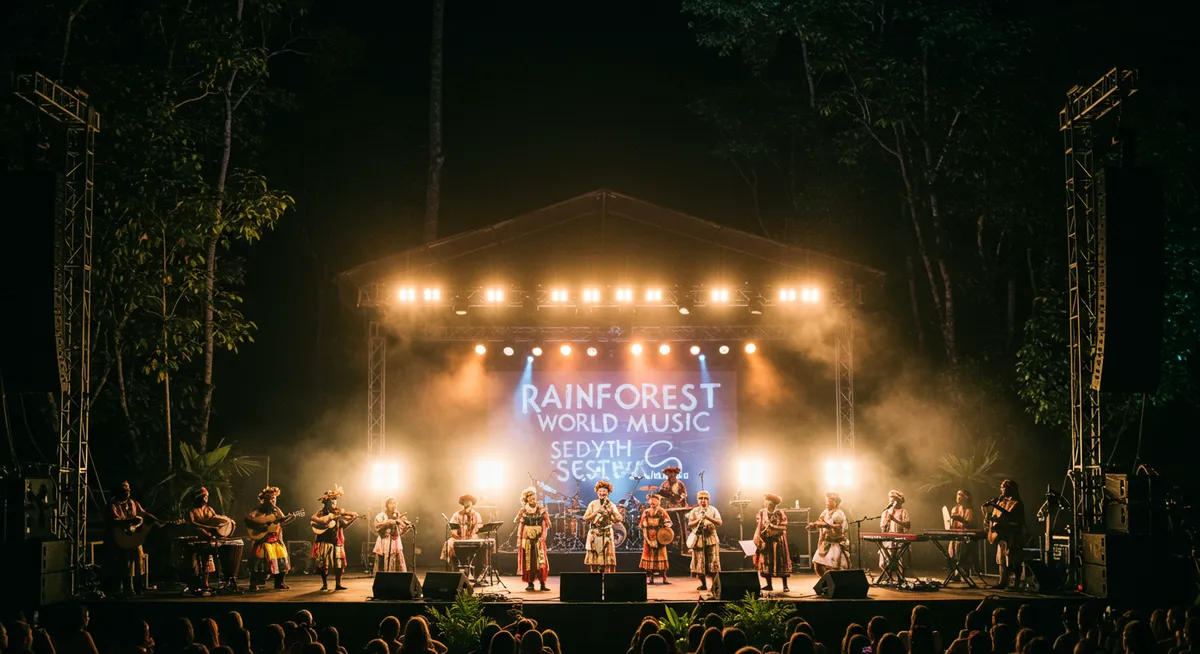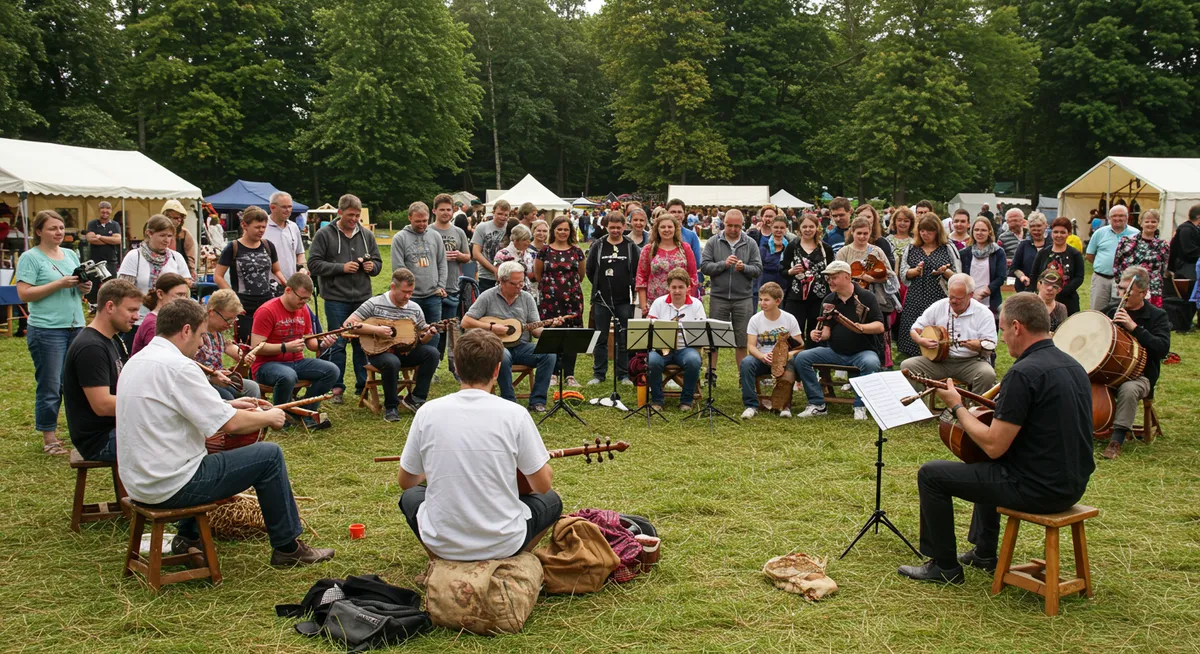Rainforest World Music Festival Malaysia | Borneo's Cultural Celebration

Rainforest World Music Festival: A Celebration of Global Indigenous Music in Borneo's Jungle
Deep in the lush rainforests of Malaysian Borneo, an extraordinary cultural celebration takes place each July that has evolved from modest beginnings into one of Asia's most acclaimed world music events. The Rainforest World Music Festival (RWMF) transforms the grounds of the Sarawak Cultural Village near Kuching into a vibrant gathering where indigenous musicians from across the globe share their traditions through performances, workshops, and cultural exchange. This unique three-day festival offers visitors an unparalleled opportunity to experience diverse musical heritages in a spectacular jungle setting, creating a harmony between environmental appreciation and cultural preservation that distinguishes it from any other music festival in the world.

Festival Origins and Evolution
From humble beginnings, RWMF has grown into an internationally recognized celebration:
Foundation and Vision
The festival emerged from a unique cultural vision:
- First Edition: Established in 1998 with a modest gathering of performers and around 300 attendees
- Founding Vision: Created by the Sarawak Tourism Board and Canadian musician Randy Raine-Reusch to showcase indigenous music in an authentic setting
- Cultural Mission: Founded with the dual purpose of preserving traditional musical forms while facilitating cross-cultural dialogue
- Sustainable Growth: Gradually expanded while maintaining connection to its core values of cultural authenticity and environmental respect
International Recognition
The festival has earned significant global acclaim:
- Industry Awards: Recognized by prestigious Songlines Music Awards as one of the top international music festivals
- Global Participation: Now draws musicians from every continent and audiences from over 50 countries
- Media Coverage: Featured in major international publications including CNN Travel, BBC, and National Geographic
- Cultural Significance: Recognized as a crucial platform for preserving and promoting endangered musical traditions
The Festival Experience
RWMF offers a multi-faceted experience combining music, education, and cultural immersion:
Unique Festival Format
The event follows a distinctive structure across its three-day program:
- Daytime Workshops: Interactive sessions where artists demonstrate techniques, explain cultural contexts, and collaborate across traditions
- Evening Concerts: Main stage performances featuring both solo traditions and collaborative pieces developed during the festival
- Mini Sessions: Intimate performances on smaller stages allowing closer audience connection with specific traditions
- Jamming Sessions: Spontaneous collaborations between musicians from different traditions, often producing extraordinary musical fusions

Musical Diversity
The festival showcases an extraordinary range of musical traditions:
- Indigenous Borneo Music: Sarawak's own traditions feature prominently, including sape (boat lute) music of the Orang Ulu and Bidayuh bamboo instruments
- Asian Traditions: From Mongolian throat singing to Indian classical music, Japanese taiko drumming to Korean percussion
- Global Indigenous Voices: Featuring traditions from Native American, African, Celtic, Nordic, Pacific Islander, and Latin American cultures
- Fusion Performances: Contemporary artists who blend traditional elements with modern influences, creating new expressions of ancient forms
Beyond Music
The festival encompasses cultural elements beyond performances:
- Craft Village: Demonstrations and sales of traditional crafts from Sarawak's diverse ethnic groups
- Food Bazaar: Extensive offerings of Sarawakian and international cuisine, emphasizing local specialties
- Wellness Area: Traditional healing practices, yoga sessions, and meditation opportunities
- Environmental Activities: Educational programs highlighting rainforest conservation and indigenous sustainability practices
The Exceptional Setting
The festival's location is integral to its unique character:
Sarawak Cultural Village
The venue itself serves as a living museum of Borneo's cultural heritage:
- Living Museum: A 17-acre site featuring authentic replicas of traditional dwellings from Sarawak's major ethnic groups
- Natural Amphitheater: Main stages set against the backdrop of Mount Santubong and surrounded by primary rainforest
- Cultural Context: Traditional buildings serve as both workshops venues and visual reminders of the cultural contexts behind the music
- Interactive Environment: Visitors can explore traditional longhouses, bamboo houses, and other indigenous structures between performances
Environmental Integration
The festival emphasizes harmony with its natural surroundings:
- Rainforest Setting: Performances take place amid the sounds and atmosphere of Borneo's ancient jungle
- Sustainability Practices: Increasing emphasis on reducing environmental impact through waste management and energy conservation
- Conservation Messaging: Educational components highlight the importance of preserving Borneo's unique biodiversity
- Weather Considerations: The tropical setting means occasional rain showers become part of the experience, with performances continuing regardless

Cultural Significance and Impact
Beyond entertainment, the festival serves important cultural functions:
Preservation of Traditional Music
The event plays a vital role in cultural conservation:
- Platform for Endangered Traditions: Provides international exposure for musical forms at risk of disappearing
- Documentation Efforts: Archives performances and workshops, creating valuable records of traditional techniques
- Intergenerational Transfer: Encourages young musicians to learn and continue their cultural heritage
- Dignity and Pride: Elevates indigenous musical traditions to the same level of respect accorded to mainstream forms
Cross-Cultural Exchange
The festival creates unique opportunities for cultural dialogue:
- Artist Collaborations: Musicians from vastly different traditions discover common ground and create new fusion forms
- Audience Education: Visitors gain deeper understanding of global cultural diversity through direct engagement
- Technical Exchange: Musicians share playing techniques, instrument construction methods, and musical structures
- Cultural Diplomacy: Creates positive international relationships through mutual appreciation of artistic traditions
Economic and Tourism Impact
The festival generates significant benefits for the region:
- Cultural Tourism: Has become a cornerstone of Sarawak's tourism strategy, attracting international visitors
- Local Enterprise: Provides economic opportunities for local craftspeople, food vendors, and service providers
- Indigenous Livelihoods: Creates markets for traditional crafts and performances beyond the festival itself
- International Visibility: Raises awareness of Sarawak as a cultural destination separate from mainstream Malaysian tourism
Experiencing the Festival as a Visitor
For travelers seeking to attend this unique celebration, practical considerations enhance the experience:
Practical Information
Essential details for planning your visit:
- Festival Dates: Typically held over a weekend in July (dates vary annually, announced several months in advance)
- Location: Sarawak Cultural Village, approximately 35km (22 miles) from Kuching, Sarawak's capital city
- Ticket Options: Available as single-day or full festival passes, with early bird discounts typically offered
- Daily Schedule: Workshops run from approximately 10:30 AM to 6:30 PM, with main stage performances from 7:00 PM until midnight
Accommodation Options
Places to stay during the festival:
- Damai Beach Area: Several resorts within walking distance of the festival grounds offer convenience but book out months in advance
- Kuching City: More accommodation options, requiring shuttle transportation to the festival (35-45 minute journey)
- Festival Camping: Basic camping facilities available on-site for the most immersive experience
- Homestays: Opportunities to stay with local families in nearby villages for cultural immersion
Visitor Tips
Maximizing your festival experience:
- Weather Preparation: The tropical climate means hot days, potential afternoon showers, and more comfortable evenings
- Workshop Strategy: Plan your daytime schedule to experience diverse traditions rather than focusing only on familiar styles
- Cultural Etiquette: Some performances have spiritual or ceremonial aspects requiring respectful behavior
- Photography Considerations: While generally welcomed, some traditional performances may have restrictions
- Extended Stay: Consider adding pre or post-festival days to explore Sarawak's national parks, orangutan sanctuaries, and cultural sites

Beyond the Music: Extending Your Sarawak Experience
Many festival attendees combine the event with broader exploration of Borneo:
Kuching and Surroundings
The charming capital offers complementary cultural experiences:
- Waterfront Heritage: Explore Kuching's colonial architecture, traditional markets, and riverside promenade
- Sarawak Museum: Discover one of Southeast Asia's finest ethnographic collections
- Ethnic Neighborhoods: Wander through the city's Chinese temples, Malay kampungs, and Indian quarter
- Culinary Exploration: Sample Sarawak's distinctive cuisine combining indigenous, Chinese, and Malay influences
Natural Wonders
Sarawak offers extraordinary natural environments:
- Bako National Park: Accessible day trip featuring proboscis monkeys, jungle trails, and dramatic coastal landscapes
- Semenggoh Wildlife Centre: Opportunities to see semi-wild orangutans during feeding sessions
- Gunung Gading National Park: Home to the world's largest flowering plant, the Rafflesia
- Mulu National Park: Further afield but worth the journey for its spectacular caves and karst formations
Indigenous Community Visits
Opportunities for deeper cultural engagement:
- Iban Longhouse Stays: Experience traditional communal living with Sarawak's largest indigenous group
- Bidayuh Villages: Visit communities known for their unique round houses and bamboo crafts
- Kelabit Highlands: Trek to remote villages in Sarawak's interior mountains
- Penan Craft Centers: Meet members of Sarawak's formerly nomadic hunter-gatherer community
Plan your Rainforest World Music Festival experience
For the most complete experience, purchase a three-day pass and balance your time between daytime workshops, where you'll learn about musical traditions directly from practitioners, and evening performances showcasing these traditions in their full glory.
Book accommodation well in advance (at least 6 months) as the festival's growing popularity means local options fill quickly, especially at the nearby Damai Beach resorts within walking distance of the venue.
Explore More Asian Cultural Festivals
If you're fascinated by the Rainforest World Music Festival, discover other extraordinary Asian celebrations that showcase the continent's rich cultural heritage:
Naadam Festival
Mongolia's celebration of nomadic culture with traditional wrestling, archery, and horse racing competitions.
Gion Matsuri
Japan's magnificent month-long festival with elaborate float processions and traditional arts.
Esala Perahera
Sri Lanka's grand procession with decorated elephants, traditional dancers, and ancient Buddhist rituals.
Hornbill Festival
India's "Festival of Festivals" showcasing the diverse tribal cultures of Nagaland.
Ghost Festival
East Asian tradition honoring ancestors with lanterns, offerings, and spiritual ceremonies.
Vegetarian Festival
Thailand's intense celebration featuring spiritual purification and spectacular body-piercing rituals.
Return to our Asian Cultural Festivals Guide to discover more extraordinary celebrations across the continent.